





Sideways in Santa Barbara Wine Country
Written By: SUSANNE LOMATCH
We've all seen the movie. Was Miles' soulful devotion to the Pinot of Santa Rita Hills worth the bargain? We finally decided to find out.
Every year we usually plan a long trip around our anniversary in mid-November. Last year we
spent a month in New Zealand and a week in Tasmania on a caravan adventure, where we discovered
some incredible Pinots and aromatic whites. Our devotion to the American Pinot has already led us
a few years ago through the Willamette and Russian River AVAs. Will Santa Rita Hills top them all?
Fall after the harvest (late October, November) is a great time to visit Santa Barbara, where crowds
are non-existent and the air is cooler for such sporting activities as biking through the wine country.
Having caught the caravan bug touring through New Zealand wine regions, we decided to make this a trip
with our new travel trailer and check out the accommodations for RVers. Buellton is the center of the
wine country, with a large RV park (Flying Flags)
that caters to every type of RVer, from mammoth luxury motorcoach rigs to small travel trailers. As it
turns out, this resort park is adjacent to “The Windmill,” that iconic motel that Miles and Jack shacked
up at during their weeklong bachelor escapade.
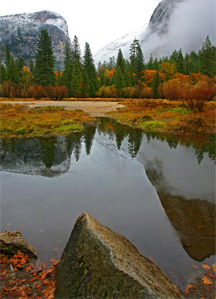 Boise to Buellton. The drive from Boise to Buellton is about 1000 miles, with the possibility of
several routes. The one we chose took us through Tahoe, down along scenic 395 and Mono Lake, site of the
rugged Tioga Pass entrance to Yosemite. We camped several nights in Yosemite, awed by the quiet November
scenery and rejoiced by a campground meal of steamed lobster tail and a bottle of aged Cava – marking our
21st year together. (A collection of photography I shot at Yosemite can be found
here.)
From Yosemite we passed through Fresno and the fertile central valley (I’ve never seen so many raisin farms!),
Paso Robles (another incredible wine country we plan to visit soon) and finally Pismo Beach (where we
discovered a most soothing quality of sand). Buellton is a short drive south along 101.
Boise to Buellton. The drive from Boise to Buellton is about 1000 miles, with the possibility of
several routes. The one we chose took us through Tahoe, down along scenic 395 and Mono Lake, site of the
rugged Tioga Pass entrance to Yosemite. We camped several nights in Yosemite, awed by the quiet November
scenery and rejoiced by a campground meal of steamed lobster tail and a bottle of aged Cava – marking our
21st year together. (A collection of photography I shot at Yosemite can be found
here.)
From Yosemite we passed through Fresno and the fertile central valley (I’ve never seen so many raisin farms!),
Paso Robles (another incredible wine country we plan to visit soon) and finally Pismo Beach (where we
discovered a most soothing quality of sand). Buellton is a short drive south along 101.
Santa Barbara Wine Country. SBWC encompasses four major appellations or American Viticultural Areas (AVAs):
Santa Rita Hills, Santa Ynez Valley, Happy Canyon and Santa Maria Valley, almost 21,000 acres of vineyard area.
Santa Rita Hills, Santa Maria and the area in between, Los Alamos, are known for producing Pinot Noir and
Chardonnay varietals due to the cool coastal climate. Santa Ynez is inland and hotter, and more conducive
to growing Rhone and Italian varietals such as Syrah and Sangiovese. Happy Canyon is at the eastern edge of
Santa Ynez Valley and has only recently attained AVA status; it excels at growing Bordeaux and Rhône varietals.
Los Alamos Valley is an unrecognized area within SBWC; if you find bottles labeled “Santa Barbara County” it is
likely that the wine contains grapes sourced from that area. A good place to find AVA maps with winery descriptions
from which to plan a visit is the Santa Barbara County Vintner’s Association.
The majority of the tasting rooms we visited charge a tasting fee, and a hefty one at that: average was
about $7-$10pp but usually included a small wine glass with the winery label as a takeaway. Many of the
wineries do not refund the charge with purchase. While this trend may be growing in California, we find
it to be customer unfriendly, although from a business perspective it probably makes sense in terms of
helping to make up for the loss in running the tasting room. We wonder what Miles and Jack would have
done with all of those collected wine glasses!
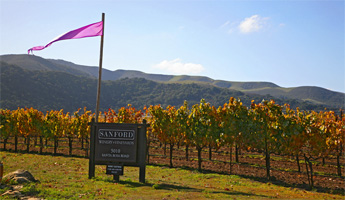 Sanford v. Alma Rosa. After dropping the trailer at the RV park, we made a late afternoon drive up Santa Rosa Road,
a pilgrimage to the venerable Sanford of Santa Rita Hills.
Fall colors and a late afternoon sun captivated the scenery. For those who don’t follow the history of great wineries,
Sanford was started by Richard Sanford, who planted the first Pinot vineyard (‘Sanford & Benedict’ of Santa Rita Hills)
in 1970, opened the Sanford winery in 1981, attained a significant following (including the notoriety from Sideways)
and sold his winery and brand in 2005 to the Terlato Wine Group, a wealthy family owned winery holding company that
now retains the brand and original winery tasting room site. Having known virtually nothing about Sanford short of
the introduction through Sideways, we briskly dashed into the tasting room before closing. Sampling a few Chardonnays
and Pinots, we can confidently say we were singularly won over by the 2007 Sanford & Benedict single vineyard Pinot –
grapes sourced from that original vineyard planted in the 70s – near perfect balance and weight, rose and asparagus
notes. Aging potential. Beautiful label. Smiles for our new treasure, we returned to Buellton, but not before stopping
at the still open Alma Rosa (“soul of rose”).
Sanford v. Alma Rosa. After dropping the trailer at the RV park, we made a late afternoon drive up Santa Rosa Road,
a pilgrimage to the venerable Sanford of Santa Rita Hills.
Fall colors and a late afternoon sun captivated the scenery. For those who don’t follow the history of great wineries,
Sanford was started by Richard Sanford, who planted the first Pinot vineyard (‘Sanford & Benedict’ of Santa Rita Hills)
in 1970, opened the Sanford winery in 1981, attained a significant following (including the notoriety from Sideways)
and sold his winery and brand in 2005 to the Terlato Wine Group, a wealthy family owned winery holding company that
now retains the brand and original winery tasting room site. Having known virtually nothing about Sanford short of
the introduction through Sideways, we briskly dashed into the tasting room before closing. Sampling a few Chardonnays
and Pinots, we can confidently say we were singularly won over by the 2007 Sanford & Benedict single vineyard Pinot –
grapes sourced from that original vineyard planted in the 70s – near perfect balance and weight, rose and asparagus
notes. Aging potential. Beautiful label. Smiles for our new treasure, we returned to Buellton, but not before stopping
at the still open Alma Rosa (“soul of rose”).
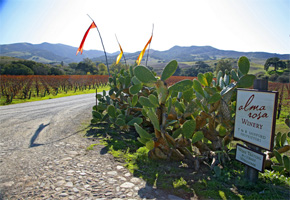 There we met a few relaxed gentlemen pouring at the rustic tasting room. We seem to remember one of them pouring wine
for Miles and Jack on their visit too. Alma Rosa didn’t just offer four wines to taste, with only one single vineyard
offering. They offered twice as many, with gradations in vintage, vineyard, and clone. Yes, single clone or a blend
of two clones. Forget about vineyard cuvées. It has come down to the clone. And what did we think? We were surprised
at the differentiation between clones. The “115” was a little too Bourgogne light for our tastes; the “667” was
meatier, noting honey, blackberry, smoke and minerals. We settled on the 2007 La Encantada Pinot, a balanced blend of
two clones “667” and “Swan,” and enough tannins to age quite well for 3-5 years. During our tasting we found out the
scuttle about Sanford and Alma Rosa. Turns out Richard Sanford took his capital gain and started Alma Rosa in 2005,
disappointed with the new family corporate management at Sanford, and intent on promoting organic farming on Santa
Rita Hills soil. The new rivalry was evident in the tasting staff commentary, complete with disdain for all things
corporate “Sanford.” We generally don’t get involved in political battles, preferring to judge a product or person
based on character and quality, and this is no exception. Hopefully the two wineries will figure out how to coexist
and the mud slinging will subside. In the mean time, there are a few bottles of Sanford and Alma Rosa resting in our
cellar, waiting for a celebration.
There we met a few relaxed gentlemen pouring at the rustic tasting room. We seem to remember one of them pouring wine
for Miles and Jack on their visit too. Alma Rosa didn’t just offer four wines to taste, with only one single vineyard
offering. They offered twice as many, with gradations in vintage, vineyard, and clone. Yes, single clone or a blend
of two clones. Forget about vineyard cuvées. It has come down to the clone. And what did we think? We were surprised
at the differentiation between clones. The “115” was a little too Bourgogne light for our tastes; the “667” was
meatier, noting honey, blackberry, smoke and minerals. We settled on the 2007 La Encantada Pinot, a balanced blend of
two clones “667” and “Swan,” and enough tannins to age quite well for 3-5 years. During our tasting we found out the
scuttle about Sanford and Alma Rosa. Turns out Richard Sanford took his capital gain and started Alma Rosa in 2005,
disappointed with the new family corporate management at Sanford, and intent on promoting organic farming on Santa
Rita Hills soil. The new rivalry was evident in the tasting staff commentary, complete with disdain for all things
corporate “Sanford.” We generally don’t get involved in political battles, preferring to judge a product or person
based on character and quality, and this is no exception. Hopefully the two wineries will figure out how to coexist
and the mud slinging will subside. In the mean time, there are a few bottles of Sanford and Alma Rosa resting in our
cellar, waiting for a celebration.
Hitching Post II. Buellton and neighboring Solvang have several wine bars, but none more popular than the
Hitching Post – the place Miles declared his home away
from home. What makes the HP unique is that it features its own varietal and blend extensive line of wines
(Hartley-Ostini “Hitching Post Wines”).
HP is a full-service restaurant, offering triple sized meals of hearty cuisine, but the real draw is the bustling
wine bar. We made the more than half-mile walk along the stretch of busy road and car dealerships just to get into
the spirit. Parsing through the sample tasting menu, we can say that although the whites and a rosé where passable,
the reds held our attention. Notable are the 2006 and 2007 Highliner Pinot, a super cuvée of four famed vineyards in
Santa Rita Hills and two vineyards in Santa Maria, and the 2006 Generation Red, a Central Coast Meritage.
Biking Santa Rita Hills. Biking the wine country is popular, as you’ll notice signs asking cyclers to remove
their cleats before entering fancy wine tasting rooms. This was on the top of our activity list, and there are
several well-known routes through the SBWC. Decent maps of two rides specifically designed to take you through
Sideways-featured wineries are found at Sideways Ride I
and Sideways Ride II.
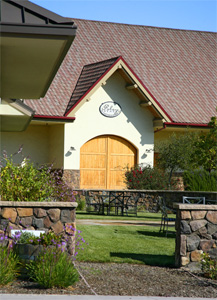 Ride I is about 50mi roundtrip, traversing through Santa Rita Hills; Ride II (~52mi) takes you from Los Olivos
up through winding, rolling Foxen Canyon Road ending at Foxen winery. We chose to do Ride I – since we are avid
Pinot fans – starting in Buellton, traveling west on 246 to Lompoc and returning on Santa Rosa Road. I usually
spit when I taste during bike trips or even when I’m driving the caravan around to the wineries, but the choice
is individual and based on alcohol tolerance – it is easy to become dehydrated when biking 50mi. We reserved
purchases for pickup a day later with the car. Three prominent wineries are located along 246, and are not to be missed.
Ride I is about 50mi roundtrip, traversing through Santa Rita Hills; Ride II (~52mi) takes you from Los Olivos
up through winding, rolling Foxen Canyon Road ending at Foxen winery. We chose to do Ride I – since we are avid
Pinot fans – starting in Buellton, traveling west on 246 to Lompoc and returning on Santa Rosa Road. I usually
spit when I taste during bike trips or even when I’m driving the caravan around to the wineries, but the choice
is individual and based on alcohol tolerance – it is easy to become dehydrated when biking 50mi. We reserved
purchases for pickup a day later with the car. Three prominent wineries are located along 246, and are not to be missed.
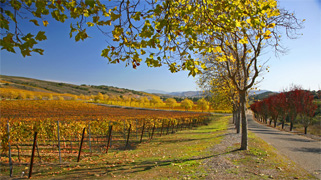 The first is Foley, a serious Pinotmaker. Foley has a
beautiful location and tasting room, especially scenic with the fall colors. We tasted several Pinots, all of
which could be cellared and enjoyed in years to come, but settled on the 2007 T Anchor Ranch Pinot, a single
vineyard clone blend that was unfiltered. Melville
and Babcock are down the road a bit and nearly co-located.
Melville’s forte is their Syrahs – dense dark inky Syrahs that are full-bodied and alive. The tasting room staff
explained their dry farming techniques, producing richer and denser wines, such as the 2006 Donna’s Syrah. Babcock
is just an all-round decent winemaker, producing several unique varietals and blends. We were wowed by a rare white
Syrah, the 2008 “Identity Crisis.” Their estate Pinot was lighter and more fruit-forward, but excellent nonetheless –
the 2008 Rita’s Earth – think fragrant roses and fertile soil. Lompoc (pronounced lom-poke!) also has a couple tasting
rooms, but our late start had us immediately heading back along Santa Rosa Road, which we knew would be a biking
challenge (especially that 500ft climb about halfway back!), albeit a very scenic one among the leaf-turning vineyards
and rolling hills. Having already visited Sanford and Alma Rosa, the last stop we made was Lafond, before realizing
that it was getting dark and we had several more miles to go. Neither of us had lights, and we found it creepy biking
in the dark, but it was a cool end to an adventurous day. To replenish the zapped energy we picked up a few thick NY
strips for the grill, complete with a local Pinot and yet another viewing of Sideways on the laptop.
The first is Foley, a serious Pinotmaker. Foley has a
beautiful location and tasting room, especially scenic with the fall colors. We tasted several Pinots, all of
which could be cellared and enjoyed in years to come, but settled on the 2007 T Anchor Ranch Pinot, a single
vineyard clone blend that was unfiltered. Melville
and Babcock are down the road a bit and nearly co-located.
Melville’s forte is their Syrahs – dense dark inky Syrahs that are full-bodied and alive. The tasting room staff
explained their dry farming techniques, producing richer and denser wines, such as the 2006 Donna’s Syrah. Babcock
is just an all-round decent winemaker, producing several unique varietals and blends. We were wowed by a rare white
Syrah, the 2008 “Identity Crisis.” Their estate Pinot was lighter and more fruit-forward, but excellent nonetheless –
the 2008 Rita’s Earth – think fragrant roses and fertile soil. Lompoc (pronounced lom-poke!) also has a couple tasting
rooms, but our late start had us immediately heading back along Santa Rosa Road, which we knew would be a biking
challenge (especially that 500ft climb about halfway back!), albeit a very scenic one among the leaf-turning vineyards
and rolling hills. Having already visited Sanford and Alma Rosa, the last stop we made was Lafond, before realizing
that it was getting dark and we had several more miles to go. Neither of us had lights, and we found it creepy biking
in the dark, but it was a cool end to an adventurous day. To replenish the zapped energy we picked up a few thick NY
strips for the grill, complete with a local Pinot and yet another viewing of Sideways on the laptop.
Los Olivos and Solvang Tasting Rooms. Our habitually lengthy breakfast and Internet rout in the RV had us
sluggishly wondering where to go for the day. We thought we’d concentrate our energy on several close by tasting
rooms. Tasting rooms that are independent of wineries are common in many wine countries, and are well worth a visit
for the diverse number of wines they feature. They are usually owned and staffed by passionate and knowledgeable
oenophiles that have taken the time to source quality wines, especially from boutique winemakers that do not have
the infrastructure of a winery tasting room.
Los Olivos Tasting Room & Wine Shop is
just such a place, where we met Jeff, and appreciated his mordantly forthright commentary regarding Santa Barbara
and San Luis Obispo wines and winemakers. What we were taken with were two offerings from local Santa Ynez small
boutique producers: 2005 Happy Canyon Vineyards
Barrack Meritage (big, bold, complex, unusual hint of musty hay, huge aging potential) and a 2006 Kellner Buoni
Anni Sangiovese (dense, full-bodied, much like those produced in WA state). Though there were several Pinots at
the tasting, none were from SBWC and we were not as taken with their quality. We continued to experience more of
the prodigy of Santa Ynez wines at two tasting rooms in Solvang. The
Olive House features Santa Barbara grown olives paired
with wines from a few local wineries. Though all of the olive pairings with wines were a unique taste sensation,
we were especially taken with a 2007 “Twelfth Night” Sauvignon Blanc from Santa Ynez sourced grapes (ripe ruby
red grapefruit and minerals). We also couldn’t pass on a bottle of strawberry-infused balsamic vinegar. The
Wandering Dog Wine Bar, run by a mother and son
team, offers a comfortable setting for wine tasting in flights paired with light gourmet appetizers. Wines in
a six-taste flight can be substituted with hard-to-find domestic and foreign microbrews, an instant appeal to
my husband! Two Santa Ynez offerings were standouts: a 2008 Tierra Alta Viognier from
Departure Wines and a 2007 Larner Grenache from
Kenneth-Crawford.
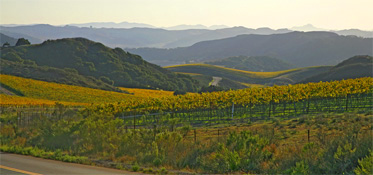 Foxen Canyon Road to Santa Maria. Biking the Foxen Canyon wine trail was an appealing option, but with
limited days left for our stay we decided to combine Foxen Canyon and Santa Maria by car, which entails about
75 miles of driving roundtrip from Buellton. Wineries are sparsely laid out among the rolling hills and winding
road of Foxen Canyon and the flatter farm country of Santa Maria. In general we were disappointed with the wines
from both of these areas. Our guess is that the terroir-climate is just not at the same level as Santa Rita Hills
for Pinots and Chards and Santa Ynez/Happy Canyon for everything else, but specifically Rhone and Bordeaux varietals.
In general the Pinots we tasted were sugary or too lightweight; the Syrahs either vegetal, sulfurous or molasses
thick. Having said that, two standouts were Foxen, where
we were treated to a nice dry farmed 2006 Tinaquaic Syrah (bacon, earth and minerals) and
River Bench, which sported fruit-forward Pinots and rich,
flavorful Chards, in particular the 2006 Estate Pinot Noir and the 2007 Estate Chardonnay.
Foxen Canyon Road to Santa Maria. Biking the Foxen Canyon wine trail was an appealing option, but with
limited days left for our stay we decided to combine Foxen Canyon and Santa Maria by car, which entails about
75 miles of driving roundtrip from Buellton. Wineries are sparsely laid out among the rolling hills and winding
road of Foxen Canyon and the flatter farm country of Santa Maria. In general we were disappointed with the wines
from both of these areas. Our guess is that the terroir-climate is just not at the same level as Santa Rita Hills
for Pinots and Chards and Santa Ynez/Happy Canyon for everything else, but specifically Rhone and Bordeaux varietals.
In general the Pinots we tasted were sugary or too lightweight; the Syrahs either vegetal, sulfurous or molasses
thick. Having said that, two standouts were Foxen, where
we were treated to a nice dry farmed 2006 Tinaquaic Syrah (bacon, earth and minerals) and
River Bench, which sported fruit-forward Pinots and rich,
flavorful Chards, in particular the 2006 Estate Pinot Noir and the 2007 Estate Chardonnay.
Last Call on the Bikes. On our last day in a wine country we usually either return to wineries that were
exceptional to buy more of the wines we liked, or we visit wineries we missed that collected repeated recommendations
from locals. Two of the latter were within biking distance (10mi roundtrip) of Buellton:
Scott Cellars in Los Olivos and
Beckman just on the outskirts. Peter Scott is a small
lot winemaker with a tasting room and has racked up numerous awards for his Pinots. He is a passionate raconteur
on his journey with wines and the wine making and marketing business, having spent years as a distributor agent
in California, only to go back to school to study formal oenology and turn full-blown wine maker. His entrepreneurial
story deserves to be told, but basically it is one of hard work and the passion for wines that begin with sourcing
just the right grapes. We really got a sense of how important it is to walk the vineyards, taste the fruit and
measure the potential of the source. Scott sources his wines from primarily from Santa Maria and Paso Robles, and
does extensive experimentation with the blending process to arrive at his product. Notable were his 2007 Pinot Gris,
blended with Chardonnay to emphasize a little oak age and fuller body, and one of the few whites we’d had in SBWC
as a standout. The 2007 Sierra Madre Pinot Noir won best Pinot at the SF Wine Competition, a medium-light body
Pinot with a rich fruit forward style. And to knock your socks off in the big and bold department: the 2007 “Cuvee J,”
an uncommon Zin and Syrah blend from Paso Robles/Central Coast grapes. Scott was happy to greet us bedecked cyclers
with even more stories of hiking the Routeburn Track in New Zealand and his passion for the Pinots of Central Otago.
Beckman is a beautiful vineyard and winery, easy to get to on the bikes. Owner-winemakers Tom and Steve Beckman share
that passion for fine Rhône blends, and as such, we were treated to a spate of Rhône Style varietals and blends. The
real find here was the (genetic) differentiation between blends of clones and single clones. In particular, I was
blown away by the 2007 Purisima Mtn Clone #1 Syrah, a single clone offering that tasted so much more complex, intense
and opulent than the clone blend cousins, the Block Six and the Barrel Select. It really drives home what fine
winemaking has evolved into: more emphasis on the pedigree of the fruit from the start.
Final Impressions. While the Pinots of Santa Rita Hills made a persuasive mark (ah, those “slippery pleasures
of Pinot” at Miles’ urging) with their distinguished weight, complexity and aging potential, the wines of Santa Ynez
(more specifically, Happy Canyon, the east end of Santa Ynez) stand out with their surprising prodigy. The
breadth of wines – Sauvignon Blancs, Viogniers, Syrahs, Cabs, Sangios and red Bordeaux, Meritage,
Rhône-style blends – are exceptional and are under the radar in terms of quality vs. price. The unspoiled
country charm of the wine country – Buellton, Solvang and Los Olivos – is surprising given the proximity to
major metro areas; a visit in the off season perhaps accentuated our experience with more attention at wine
tasting rooms. Miles would approve.
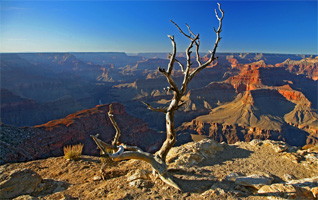
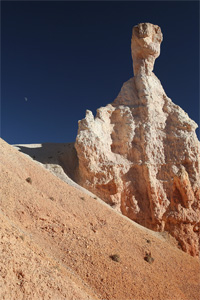 Buellton to Boise. The road home involved a 600mi day drive from Buellton southeast/east through Ventura, Valencia,
desert California and Barstow, a long stretch on I40, ending at the Grand Canyon N.P., where there was no NPS staff on
entrance gate duty at midnight. (Route 126 between Ventura and Valencia is a surprisingly scenic drive.)
We camped a few nights in the park, taking advantage of cooler weather and excellent visibility to hike into the canyon
and bike the shuttle only access roads along the rim. Bryce Canyon is a shorter drive north along diversely scenic Rt. 89;
we camped a few more nights and braved the early single digit temps, only to have that inconvenience pay off in terms of
natural phenomena – the canyon was on fire that day! (A collection of photography I shot at the Grand and Bryce Canyons
can be found here and
here.
Don’t miss a look with a glass of Pinot in hand!) Early season skiing at Park City was not to be, with the snows still
to come. We celebrated Thanksgiving dinner and our wonderful life together, toasting the occasion with a fine Santa
Rita Hills Pinot. We can only hope that Miles and Maya found the same passions.
Buellton to Boise. The road home involved a 600mi day drive from Buellton southeast/east through Ventura, Valencia,
desert California and Barstow, a long stretch on I40, ending at the Grand Canyon N.P., where there was no NPS staff on
entrance gate duty at midnight. (Route 126 between Ventura and Valencia is a surprisingly scenic drive.)
We camped a few nights in the park, taking advantage of cooler weather and excellent visibility to hike into the canyon
and bike the shuttle only access roads along the rim. Bryce Canyon is a shorter drive north along diversely scenic Rt. 89;
we camped a few more nights and braved the early single digit temps, only to have that inconvenience pay off in terms of
natural phenomena – the canyon was on fire that day! (A collection of photography I shot at the Grand and Bryce Canyons
can be found here and
here.
Don’t miss a look with a glass of Pinot in hand!) Early season skiing at Park City was not to be, with the snows still
to come. We celebrated Thanksgiving dinner and our wonderful life together, toasting the occasion with a fine Santa
Rita Hills Pinot. We can only hope that Miles and Maya found the same passions.